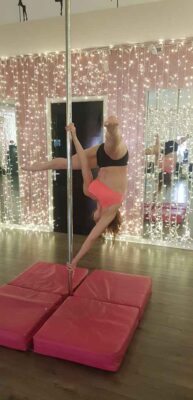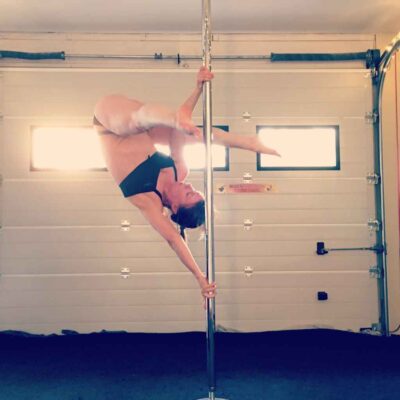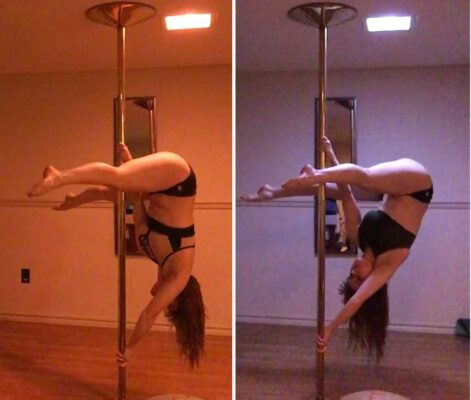StudioVeena.com › Forums › Discussions › Ayesha
-
Ayesha
Posted by Nat on November 1, 2018 at 6:23 amI have managed to get my ayesha but not able to hold it for that long. I have tried few times after but no success. I am posting my pic could you lovely people tell me it looks OK to you? Any advice welcome 🤗
Veena replied 6 years, 5 months ago 5 Members · 16 Replies -
16 Replies
-
-
Thank you. I wonder if I look up I will be able to balance it better? 🤔
-
They say there should be a straight line along your bottom hand and up to your bum and that the top arm should be bend if you are using true grip but Veena doen’t mention those things so I don’t know.
-
Yes I heard about the bent top arm too. I have seen few pictures when it’s bent slightly. It’s hard to remember it all when you trying to focus on balance. Maybe Veena can shed some light on it please. Definitely there is a lot to work on ☺
-
I actually cannot wait for me next session to work on it again! I am a coward when it comes to work on it at home on my own 😂
-
Looks great! I look down in mine (just like in handstands etc)…unless I’ve planned some kind of trick that I might need to have my eye on the pole for, then I might switch my gaze. You can choose to do what feels natural 🙂
Bending the arm is more about where you want to be positioned, neither way is right or wrong. I’ve got a TON of new things in the works so stay tuned 🙂
-
@Nat – Lucky you to have this in your classes at a studio. My studio is too small atm when it comes to amount of people so advanced couses cannot start because of too few who want them :/ So I do my Ayesha alone with a couple of pole friends in a garage as you see haha 🙂 Looking up makes me a lot less scared and more balanced in any trick.
@Veena – can’t wait to see and try the new stuff you are talking about! Have recently had the major setback because of a rib injury and now regaining my streingth and stamina. This site helps me so much! -
I’ve always heard that looking up is better because it helps to maintain a hollow body and engage the core, which helps with balance and alignment. This is true not only for Ayesha, but also butterfly, extended butterfly, inverted D, etc.
-
Here’s how I teach this move now and in person.
First, I don’t mention head position and see what they naturally do. If they don’t seem to have a preference I teach head looking at the floor just as you would for any other balance moves on the ground. Like handstand, in fact try this. Do a handstand in the middle of the floor and look up, unless you have a solid handstand and lots of experience, head up or neutral will not (usually) be an optimal position for learning balance. Looking at the floor is usually the most common instruction and usually most helpful. I say usually because there are always exceptions and a good instructor knows this and will be able to accommodate. This is why I teach head looking at the floor first…. once they feel steady in balancing, you can move on to neutral head (looking straight at the pole) or looking up at the pole or ceiling. If the student naturally looks up, that totally fine too, but if they really struggle with balance I then have them try head down to see if that helps. Switching head placement can be an ah ha, moment in balance!
As far as hollow body, it’s not such an issue with ayasha because the legs are open and not straight. This means a lot of the “hollow” will come from correct placement of the hips and legs, as in teaching to rotate from the hips (turning knees to the floor) instead of just open leg into straddle v, ( I cover this in a few lessons ) and insuring they push through the shoulders correctly and avoid blocking them into a back and down placement.
Now if you’re talking about getting into an Ayesha from a cartwheel mount or handspring, looking up at the pole first can help them learn where to hook the foot when starting with half cartwheel.
Anyway my point is, either way is fine, go with what is most comfortable and once you nail your balance you’ll be able to place your head where ever you like!! 🙂
-
Thank you for all the input. I will have a play around with the head position and see what works better for me. The core engagement is so crucial for myself as very often I concentrate on my arms and shoulders that I “forget” my core!
-
Had to chime in because Ayesha was my nemesis for a long, long time. For the last few months I’ve been wondering how I can tighten this move up and get my hips further away from the pole – closer to the position you’ll end up in after a cartwheel mount. That tip about looking up at my legs was just what I needed. Check out the difference. It felt far more secure and balanced, but it scared me a bit. I suppose it’ll take some getting used to. Granted, there was no way in hell I would have been able to look up at my feet when I was first learning this move – that would have been waaaay too disorienting for me.
A lot of getting stable in this move was figuring out where that bottom arm was comfortable, making sure I was pulling enough with the top arm, and finding out out where my hips needed to be. Because I have very wide hips, I found I had to curve my torso towards my pulling arm slightly. I do my ayesha from caterpillar, because it feels more comfortable for me. But I have to make sure I point my toes and drop them towards the ground the second my legs are off the pole or else I fall crotch-first into the pole. I’m going to try bending my arm a little next time I practice this move and see what that does for me.
Veena, I’m so looking forward to the new things you have in the works. 🙂
-
Yes, that’s exactly the progression I tend to see!! Look down to get your balance figured out, then move on to neutral or up, because like you mentioned, it’s scary to switch your gaze to up, especially if you have a tall ceiling or an angled ceiling…. That with the body pulling away from the pole isn’t something most people are comfortable with right away. So many moves are not just “simply do this” and then you’ve got it, it’s a process. That’s why I came up with the idea of programs.
On a different note: The Ayesha a good example of move where the top wrist can be unhappy using true grip (thumb up) and one might need to switch to cup grip or TG if they have the mobility for it.
-
Veena – I find because my hands and wrists are very tiny I am always much happier/more secure in a cup grip. I’m going to play around and see if I can get it in ayesha. Would your thumb be up (closer to the ceiling) or down (closer to the ground) for a cup grip ayesha?
I’m loving the programs and how things are broken down. If one of the things you have in the works happens to be a cartwheel mount nailed it program I might just have a pole-nerd happiness meltdown. 😱
Log in to reply.



